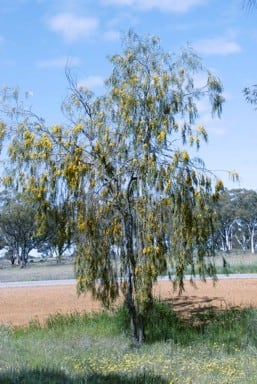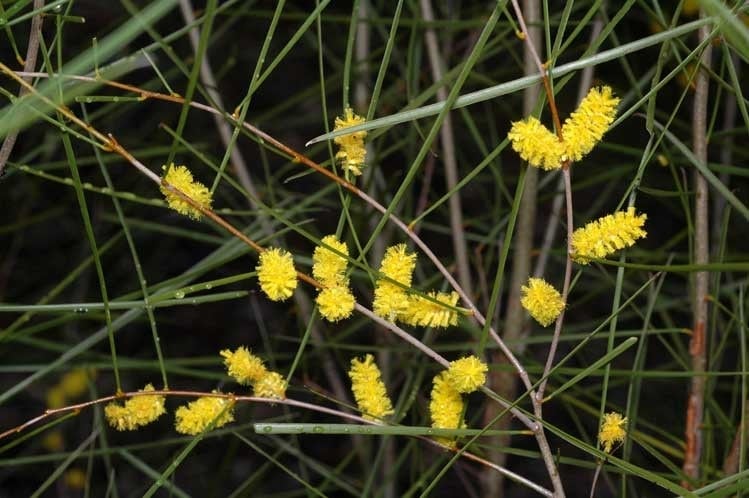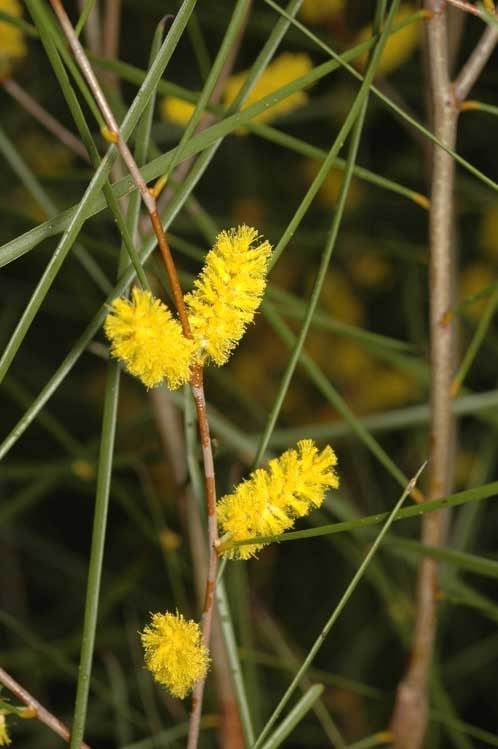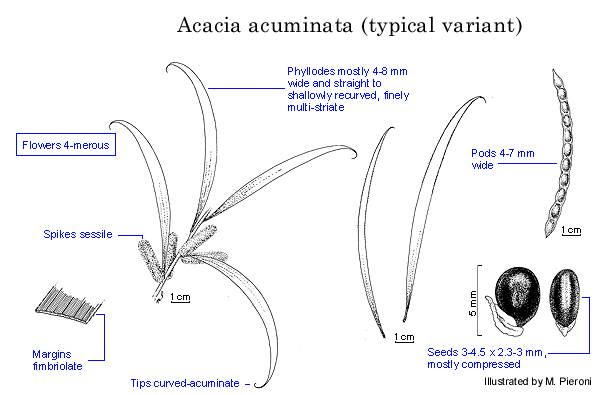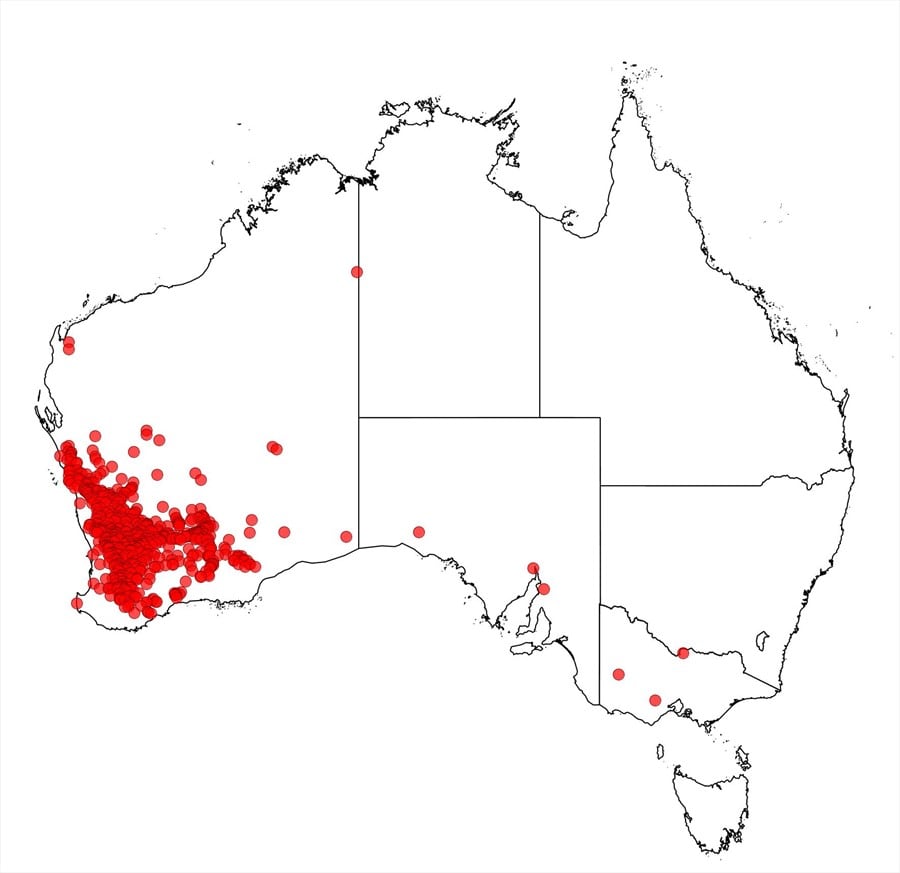Acacia acuminata Benth.
WATTLE
Acacias of Australia
Common Name
Raspberry Jam, Jam
Family
Fabaceae
Distribution
Occurs in southwestern Western Australia where it extends from just N of the Murchison River, S to Borden and E to Balladonia; outlying populations occur near Yalgoo and Paynes Find. The eastern boundary of the main area of occurrence abuts that of A. burkittii which is common in the adjacent arid zone. Incipiently adventive in some parts of Victoria.
Description
Obconic shrub or tree (2–) 3–7 (–10) m high. New shoots with silky, yellow, appressed hairs. Branchlets ascending to erect, infrequently ±pendulous, glabrous. Phyllodes ascending to erect or spreading at various angles, linear to narrowly elliptic, flat, normally straight to shallowly curved, (5–) 8–15 (–18) cm long, (1.5–) 2–8 (–10) mm wide, tapered to a curved-acuminate to caudate, non-pungent, slender apex, bright green, glabrous except fimbriolate in upper c. 1/2, finely multistriate; midnerve often the most prominent. Inflorescences simple, normally 1 or 2 in phyllode axils; spikes sessile, (7–) 10–30 mm long (dry), golden. Flowers mostly 4-merous; calyx dissected by 1/2 or more, with lobes usually narrow. Pods linear, flat but variably raised over seeds and straight-edged to constricted between them, (2–) 3–8 cm long, 2.5–7 mm wide, firmly chartaceous to thinly coriaceous-crustaceous, brown, clothed with sparse minute caducous hairs. Seeds longitudinal, oblong or elliptic to ovate, 2–4.5 mm long, 1.5–3 mm wide, compressed (1–2.5 mm thick), dark brown to black, shiny to slightly shiny; aril membranous, white or creamy white.
Phenology
Flowers c. July.–Oct.
Habitat
Often in gently undulating topography, growing in lateritic gravels or red-brown earths in low semi-arid woodlands and tall shrublands, and in clayey soils on flats and in red sands, often near intermittent streams. Source: M.D. Tindale et al., Flora of Australia 11B: 346 (2001), as subsp. acuminata.
Specimens
Typical variant (Acacia acuminata sens. str.)
W.A.: along W side of Dongolocking Rd, near farmhouse, 15.8 km NE of junction with Arthur Rd, near Wagin, R.S. & R.A. Cowan A852 (CANB, K, NY, PERTH, US); Needilup Rd, 10 km N of intersection with Jerramungup–Needilup road, G. Craig 1561 (PERTH); 7.5 km SW of Dandaragan on road to Cataby, B.R. Maslin 7781 (CANB, MEL, PERTH); Mount Bakewell Res. [near York], E of Q3, 100 m W of gully, B. Salter, C. Warburton & H. Green BS181 (MEL, PERTH).
Vic. (naturalised): Picola South Rd, 1.4 km N from intersection Lindsays Rd, V. Stajsic 5285 (MEL).
Notes
M.D. Tindale et al., Flora Australia 11B: 345–347 (2001), treated this species as comprising two subspecies. However, following a review by B.R. Maslin et al., The Acacia acuminata (Jam) group: an analysis of variation to aid Sandalwood (Santalum spicatum) plantation research (1999, unpublished report), Acacia acuminata subsp. burkittii is now considered better treated as a distinct species, Acacia burkittii. A majority of the variation within the former subsp. acuminata is now accommodated in three variants ("typical", "narrow phyllode" and "small seed"); two entities from the Geraldton region remain unresolved. These were referred to in B.R. Maslin et al. (1999), as A. acuminata/burkittii variants 1 and 2.
Apart from its very close relationships with A. burkittii, A. acuminata has affinities with A. drepanophylla, A. jibberdingensis and A. oldfieldii. However, based on the study by B.R. Maslin et al., The Acacia acuminata (Jam) group: an analysis of variation to aid Sandalwood (Santalum spicatum) plantation research (1999, unpublished report), the relationship between A. oldfieldii and A. acuminata is not as close as previously thought. These species are also related to those of the ‘A. multispicata group’.
The common name refers to the odour of freshly cut timber of the species.
The following entities account for most variation encountered within A. acuminata.
1: Pods 2.5–3 mm wide; seeds 2–3 mm long, less than 2 mm wide, 1–1.5 mm thick; phyllodes (5–) 7–10 cm long, 3–6 mm wide, straight (Kalannie–near Yalgoo)..........Acacia sp. Small seed (B.R. Maslin 7830)
1: Pods 3–7 mm wide; seeds larger than above; phyllodes often greater than 10 cm long
2: Phyllodes mostly 2–3 mm wide and straight to shallowly incurved; pods 3–5 mm wide; seeds 3–4 mm long, 1.8–2.5 mm wide, 1–1.5 mm thick (Morawa SE to Balladonia)..........Acacia sp. Narrow phyllode (B.R. Maslin 7831)
2: Phyllodes mostly 4–8 mm wide and +/- straight to recurved; pods 4–7 mm wide; seeds 2.3–3 mm wide, 1.8–2.5 mm thick (Mingenew S to Borden & Ravensthorpe area)..........Acacia acuminata sens. str.
Acacia acuminata sens. str.
Tall obconic shrub or tree 3–7 (–10) m high, single-stemmed or with few main stems, bole 0.3–1.5 (–2) m long. Branchlets occasionally ±pendulous. Phyllodes often spreading at various angles, ±straight to shallowly recurved, infrequently shallowly incurved, (6–) 8–15 (–18) cm long, (3–) 4–8 (–10) mm wide. Pods flat but variably raised over seeds and mostly shallowly to deeply constricted between them, 4–8 cm long, 4–7 mm wide. Seeds oblong or elliptic to ovate, 3–4.5 mm long, 2.3–3 mm wide, 1.8–2.5 mm thick.
Occurs principally in the western part of the wheatbelt from near Mingenew S to Borden and Ravensthorpe, with outliers at Peak Charles, c. 130 km due NE of Ravensthorpe, and near Paynes Find. The western boundary of its range is located close to Dandaragan, Toodyay and Williams; the eastern boundary is located close to Wongan Hills, Kellerberrin, Corrigin and Ongerup, and abuts that of Acacia sp. Narrow phyllode (B.R. Maslin 7831). Commonly occurs in brown loamy clay or sandy loam (pH 5.5–7) in lower parts of the landscape (often near water courses) or in low hilly country, in low eucalypt woodland; also recorded from shallow white sand over laterite, clay and from around granite outcrops.
W.A.: along W side of Dongolocking Rd, nr farmhouse, 15.8 km NE of junction with Arthur Rd, near Wagin, R.S. & R.A. Cowan A852 (CANB, K, NY, PERTH, US); Needilup Rd, 10 km N of intersection with Jerramungup–Needilup road, G. Craig 1561 (PERTH); 7.5 km SW of Dandaragan on road to Cataby, B.R. Maslin 7781 (CANB, MEL, PERTH); Mt Bakewell Res. [near York], E of Q3, 100 m W of gully, B. Salter, C. Warburton & H. Green BS181 (MEL, PERTH). Vic.: Picola South Rd, 1.4 km N from intersection Lindsays Rd, V. Stajsic 5285 (MEL).
Pendulous forms are found scattered throughout the range and in most places occur at a low frequency within populations of typical individuals (which have ascending to erect branchlets and variously spreading to ascending phyllodes).
Plants with broadest phyllodes occur mostly in the Toodyay–Katanning region; to the N and E of Toodyay the phyllodes become progressively narrower; specimens with consistently narrow phyllodes occur mainly in southern areas from Borden to Ravensthorpe. Acacia acuminata sens. str. is usually distinguished (somewhat arbitrarily) from Acacia sp. Narrow phyllode (B.R. Maslin 7831) by its generally wider, often shallowly recurved and more spreading phyllodes, generally wider pods and often slightly wider and thicker seeds. In the central and northern wheatbelt where the geographic ranges of these two entities abut it can be difficult distinguishing between them; areas where both entities appear to occur include the Kellerberrin–Merredin and Wongan Hills regions.
Acacia sp. Narrow phyllode (B.R. Maslin 7831)
Acacia acuminata (narrow phyllode variant), B.R. Maslin, in B.R.Maslin (coordinator), WATTLE Acacias of Australia CD-ROM (2001).
Obconic or rounded, multi-stemmed shrub or obconic tree 2–5 (–7) m high, sometimes with a single bole to 0.5 (–1) m long. Phyllodes ascending to erect, straight to shallowly incurved, 7–14 cm long, (1.5–) 2–4 mm wide. Pods flat but variously raised over the seeds and shallowly or sometimes moderately constricted between them, (2–) 3–8 cm long, 3–4 (–5) mm wide. Seeds longitudinal, compressed, elliptic to oblong-elliptic, oblong-ovate or ovate, 3–4 mm long, 1.8–2.5 (–3) mm wide, 1–1.5 (–2) mm thick.
Occurs in the northern, central and eastern wheatbelt region and extending just into the adjacent arid zone, from near Morawa SE to Balladonia; a few outlier populations appear to occur near Ravensthorpe on the south coast. The northern boundary of the range runs W of Wubin and close to Beacon, Southern Cross and Kalgoorlie and abuts that of A. burkittii; the southern boundary runs close to Wubin, Kellerberrin, N of Hyden and S of Norseman. Grows commonly on brown or red-brown loam or clay-loam flats (pH 6–7) in tall shrubland or open eucalypt woodland; also commonly found on sandy loam around base of granite rocks where it frequently forms dense communities.
W.A.: Wanarra, near Lake Monger, C.A. Gardner 12467 (PERTH); Phillips River crossing, c. 15 km SW of Ravensthorpe on main road to Ongerup, L. Haegi 1041 (AD, PERTH); Coolgardie, July 1899, R. Helms s.n. (PERTH); c. 26 km E of Kalannie, on Black Rd 1 km NE of Anderson Rd intersection, B.R. Maslin 7835 (MEL, PERTH).
This entity is both geographically and morphologically intermediate between A. acuminata sens. str. and A. burkittii and in the areas where their ranges abut it is sometimes difficult to distinguish between them in the absence of pods. Genetic data suggest that Acacia sp. Narrow phyllode (B.R. Maslin 7831) may be the result of (ancient) hybridization between A. acuminata sens. str. and A. burkittii, fide L. Broadhurst & D.J. Coates, Heredity 88: 250–257 (2002).
Specimens with the widest pods (to 5 mm) and widest seeds (to 3 mm wide) often occur in well-watered sites such as the base of granite rocks; these plants are often taller than those occurring elsewhere. Phyllodes can vary from 2–4 mm wide between plants within a single population.
Acacia sp. Small seed (B.R. Maslin 7830)
Acacia acuminata (small seed variant), B.R. Maslin, in B.R. Maslin (coordinator), WATTLE Acacias of Australia CD-ROM (2001). Rounded, multi-stemmed shrub or tree (2–) 3–5 m high, boles c. 1 m long, the crowns neat, compact and 2.5–6 m across. Phyllodes ascending to erect, straight, (5–) 7–10 cm long, 3–6 mm wide, acuminate to caudate point. Pods flat but prominently raised over seeds and scarcely constricted between them, 4–8 cm long, 2.5–3 mm wide. Seeds oblong-elliptic to oblong or (when very short) almost square, 2–3 mm long, 1.5–1.8 mm wide, 1–1.5 mm thick.
Occurs in the northern wheatbelt and adjacent arid zone from c. 50 km NE of Kalannie N to Jingemarra Station (N of Yalgoo) and east of Binnu; disjunct populations occur in south coastal regions S of Ongerup. The northern populations appear to occur in higher parts of the landscape in sometimes rocky, reddish or greyish brown fine loam (pH 5.5–6) or sandy clay, in open scrub or shrubland. The southern populations occur in granitic sandy loam in Eucalyptus woodland on gently undulating plains.
W.A.: northern end of Black Rd, NE of Kalannie, 3 Sept. 1996, E. Hudson s.n. (PERTH); East of Binnu, Binnu East Rd, 0.5 km E of Balla Whelarra Rd, B.R. Maslin 7796 (K, NSW, PERTH); 16 km S of Ongerup, N. Stevens KRN9521-1 (MELU, PERTH).
Distinguished from the other entities of A. acuminata by a combination of its narrow pods with small seeds and its broad phyllodes with often protracted tips.
FOA Reference
Data derived from Flora of Australia Volumes 11A (2001), 11B (2001) and 12 (1998), products of ABRS, ©Commonwealth of Australia
Author
Revised by B.R.Maslin
Dr M.D.Tindale and Dr P.G.Kodela with the assistance of M.Bedward, S.J.Davies, C.Herscovitch, D.A.Keith and/or D.A.Morrison
Further edits P.G. Kodela (January 2018), A.E. Orchard (January 2018)
This identification key and fact sheets are available as a mobile application:
URL: https://apps.lucidcentral.org/wattle/
© Copyright 2018. All rights reserved.


